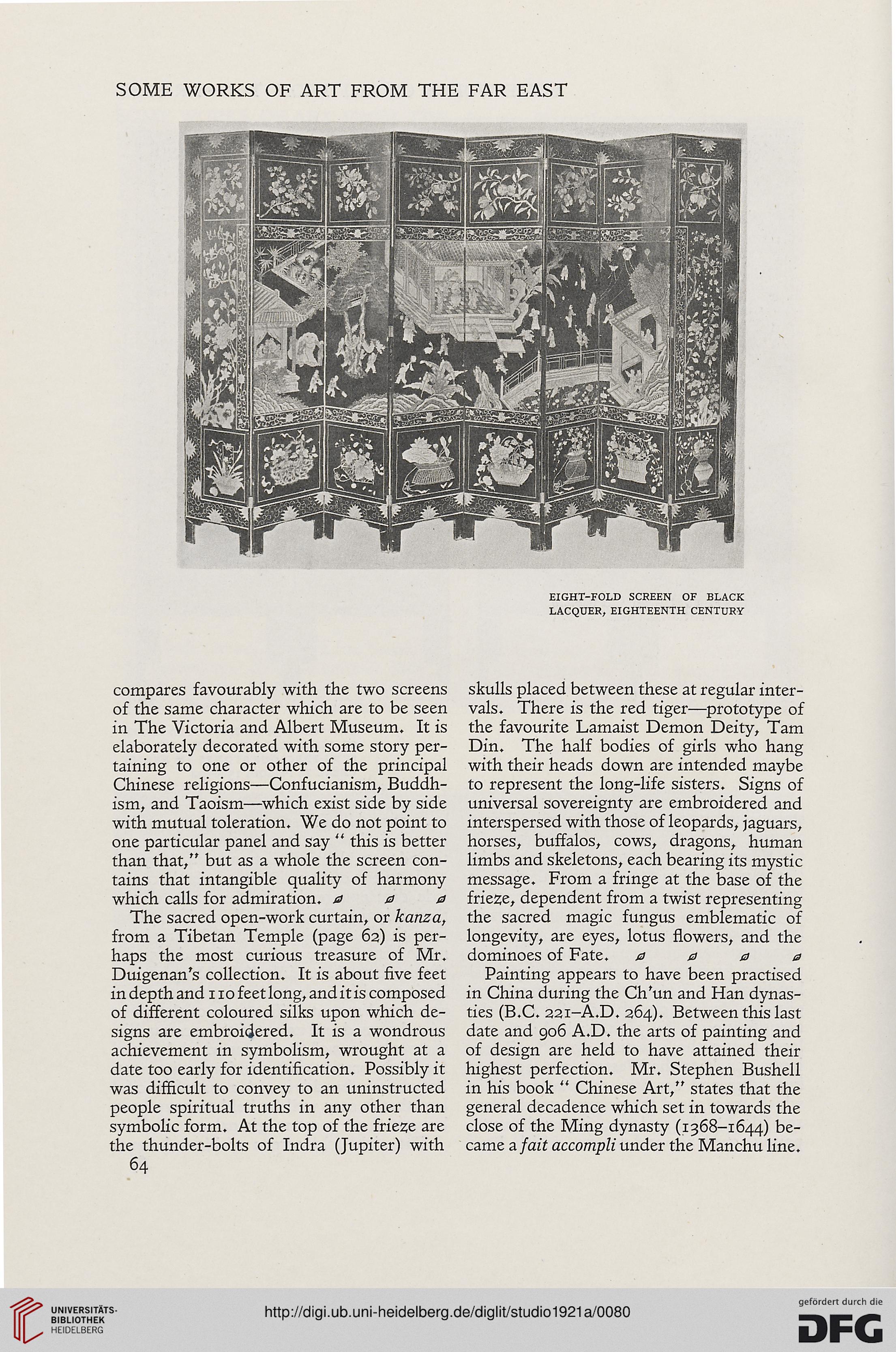SOME WORKS OF ART FROM THE FAR EAST
EIGHT-FOLD SCREEN OF BLACK
LACQUER, EIGHTEENTH CENTURY
compares favourably with the two screens
of the same character which are to be seen
in The Victoria and Albert Museum. It is
elaborately decorated with some story per-
taining to one or other of the principal
Chinese religions—Confucianism, Buddh-
ism, and Taoism—which exist side by side
with mutual toleration. We do not point to
one particular panel and say " this is better
than that," but as a whole the screen con-
tains that intangible quality of harmony
which calls for admiration, 000
The sacred open-work curtain, or kanza,
from a Tibetan Temple (page 62) is per-
haps the most curious treasure of Mr.
Duigenan's collection. It is about five feet
in depth and 110 feet long, and it is composed
of different coloured silks upon which de-
signs are embroidered. It is a wondrous
achievement in symbolism, wrought at a
date too early for identification. Possibly it
was difficult to convey to an uninstructed
people spiritual truths in any other than
symbolic form. At the top of the frieze are
the thunder-bolts of Indra (Jupiter) with
64
skulls placed between these at regular inter-
vals. There is the red tiger—prototype of
the favourite Lamaist Demon Deity, Tarn
Din. The half bodies of girls who hang
with their heads down are intended maybe
to represent the long-life sisters. Signs of
universal sovereignty are embroidered and
interspersed with those of leopards, jaguars,
horses, buffalos, cows, dragons, human
limbs and skeletons, each bearing its mystic
message. From a fringe at the base of the
frieze, dependent from a twist representing
the sacred magic fungus emblematic of
longevity, are eyes, lotus flowers, and the
dominoes of Fate. 0 0 0 a
Painting appears to have been practised
in China during the Ch'un and Han dynas-
ties (B.C. 221-A.D. 264). Between this last
date and 906 A.D. the arts of painting and
of design are held to have attained their
highest perfection. Mr. Stephen Bushell
in his book " Chinese Art," states that the
general decadence which set in towards the
close of the Ming dynasty (1368-1644) be-
came a fait accompli under the Manchu line.
EIGHT-FOLD SCREEN OF BLACK
LACQUER, EIGHTEENTH CENTURY
compares favourably with the two screens
of the same character which are to be seen
in The Victoria and Albert Museum. It is
elaborately decorated with some story per-
taining to one or other of the principal
Chinese religions—Confucianism, Buddh-
ism, and Taoism—which exist side by side
with mutual toleration. We do not point to
one particular panel and say " this is better
than that," but as a whole the screen con-
tains that intangible quality of harmony
which calls for admiration, 000
The sacred open-work curtain, or kanza,
from a Tibetan Temple (page 62) is per-
haps the most curious treasure of Mr.
Duigenan's collection. It is about five feet
in depth and 110 feet long, and it is composed
of different coloured silks upon which de-
signs are embroidered. It is a wondrous
achievement in symbolism, wrought at a
date too early for identification. Possibly it
was difficult to convey to an uninstructed
people spiritual truths in any other than
symbolic form. At the top of the frieze are
the thunder-bolts of Indra (Jupiter) with
64
skulls placed between these at regular inter-
vals. There is the red tiger—prototype of
the favourite Lamaist Demon Deity, Tarn
Din. The half bodies of girls who hang
with their heads down are intended maybe
to represent the long-life sisters. Signs of
universal sovereignty are embroidered and
interspersed with those of leopards, jaguars,
horses, buffalos, cows, dragons, human
limbs and skeletons, each bearing its mystic
message. From a fringe at the base of the
frieze, dependent from a twist representing
the sacred magic fungus emblematic of
longevity, are eyes, lotus flowers, and the
dominoes of Fate. 0 0 0 a
Painting appears to have been practised
in China during the Ch'un and Han dynas-
ties (B.C. 221-A.D. 264). Between this last
date and 906 A.D. the arts of painting and
of design are held to have attained their
highest perfection. Mr. Stephen Bushell
in his book " Chinese Art," states that the
general decadence which set in towards the
close of the Ming dynasty (1368-1644) be-
came a fait accompli under the Manchu line.




